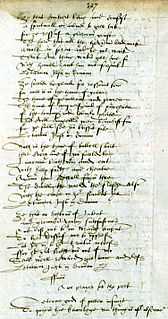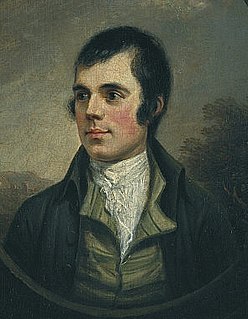Related Research Articles

William Dunbar was a Scottish makar, or a court poet active in the late fifteenth century and the early sixteenth century. He was closely associated with the court of King James IV and produced a large body of work in Scots distinguished by its great variation in themes and literary styles. He was probably a native of East Lothian, as assumed from a satirical reference in The Flyting of Dumbar and Kennedie. His surname is also spelt Dumbar.
John Rolland, Scottish poet, appears to have been a priest of the diocese of Glasgow, and to have been known in Dalkeith in 1555.

"I that in Heill wes and Gladnes", also known as "The Lament for the Makaris", is a poem in the form of a danse macabre by the Scottish poet William Dunbar. Every fourth line repeats the Latin refrain timor mortis conturbat me, a litanic phrase from the Office of the Dead.

Elizabeth Melville, Lady Culross (c.1578–c.1640) was a Scottish poet.
Alexander Scott was a Scottish Court poet. He is believed to have spent most of his time in or near Edinburgh. Thirty-six short poems are attributed to him, including Ane New Yeir Gift to Quene Mary, The Rondel of Love, and a satire, Justing at the Drum. His poems are included in the Bannatyne Manuscript (1568) complied by George Bannatyne. According to an older view, "he has great variety of metre, and is graceful and musical, but his satirical pieces are often extremely coarse".

The Flyting of Dunbar and Kennedie is the earliest surviving example of the Scottish version of the flyting genre in poetry. The genre takes the form of a contest, or "war of words", between two poets, each trying to outclass the other in vituperation and verbal pyrotechnics. It is not certain how the work was composed, but it is likely to have been publicly performed, probably in the style of a poetic joust by the two combatants, William Dunbar and Walter Kennedy, before the Court of James IV of Scotland.
The Eneados is a translation into Middle Scots of Virgil's Latin Aeneid, completed by the poet and clergyman Gavin Douglas in 1513.

The Bannatyne Manuscript is an anthology of literature compiled in Scotland in the sixteenth century. It is an important source for the Scots poetry of the fifteenth and sixteenth centuries. The manuscript contains texts of the poems of the great makars, many anonymous Scots pieces and works by medieval English poets.
The Alliterative Revival is a term adopted by literary historians to refer to the resurgence of poetry using the alliterative verse form in Middle English between c. 1350 and 1500. Alliterative verse was the traditional verse form of Old English poetry; the last known alliterative poem prior to the Revival was Layamon's Brut, which dates from around 1190.
Nationality words link to articles with information on the nation's poetry or literature.

Androw Myllar was the first Scottish printer.

The Asloan Manuscript is an anthology of Scots prose and poetry dating to the early sixteenth century. It was compiled by the Edinburgh notary John Asloan.

The Buke of the Howlat, often referred to simply as The Howlat, is a humorous 15th century Scots poem by Richard Holland.

The Chepman and Myllar Press was the first printing press to be established in Scotland.

Quhy Sowld Nocht Allane Honorit Be is an anonymous allegorical poem of the fifteenth or sixteenth century written in Scots.
The Scottish Text Society (STS) is a text publication society founded in 1882 to promote the study of Scottish literature. The Society publishes scholarly editions of important texts from the country's literary history, and has played a significant role in the revival of interest in the literature and languages of Scotland.

Scottish literature in the Middle Ages is literature written in Scotland, or by Scottish writers, between the departure of the Romans from Britain in the fifth century, until the establishment of the Renaissance in the late fifteenth century and early sixteenth century. It includes literature written in Brythonic, Scottish Gaelic, Scots, French and Latin.

Poetry of Scotland includes all forms of verse written in Brythonic, Latin, Scottish Gaelic, Scots, French, English and Esperanto and any language in which poetry has been written within the boundaries of modern Scotland, or by Scottish people.

Scots-language literature is literature, including poetry, prose and drama, written in the Scots language in its many forms and derivatives. Middle Scots became the dominant language of Scotland in the late Middle Ages. The first surviving major text in Scots literature is John Barbour's Brus (1375). Some ballads may date back to the thirteenth century, but were not recorded until the eighteenth century. In the early fifteenth century Scots historical works included Andrew of Wyntoun's verse Orygynale Cronykil of Scotland and Blind Harry's The Wallace. Much Middle Scots literature was produced by makars, poets with links to the royal court, which included James I, who wrote the extended poem The Kingis Quair. Writers such as William Dunbar, Robert Henryson, Walter Kennedy and Gavin Douglas have been seen as creating a golden age in Scottish poetry. In the late fifteenth century, Scots prose also began to develop as a genre. The first complete surviving work is John Ireland's The Meroure of Wyssdome (1490). There were also prose translations of French books of chivalry that survive from the 1450s. The landmark work in the reign of James IV was Gavin Douglas's version of Virgil's Aeneid.

"Christis Kirk on the Green" is an anonymous Middle Scots poem in 22 stanzas, now believed to have been written around the year 1500, giving a comic account of a brawl at a country fair. It was for many years mistakenly attributed either to James I of Scotland or to James V of Scotland. It gave rise to a whole tradition of humorous poems on similar subjects by Scottish poets down the centuries, including Allan Ramsay and Robert Burns, and is still one of the most frequently published works in Middle Scots. "Christis Kirk on the Green" has been called one of the finest performances in 15th-century British poetry.
References
- This article incorporates text from a publication now in the public domain : Chisholm, Hugh, ed. (1911). "Holland, Richard". Encyclopædia Britannica (11th ed.). Cambridge University Press.
- British Authors Before 1800: A Biographical Dictionary, edited by Stanley J. Kunitz and Howard Haycraft, New York, The H. W. Wilson Company, 1952.